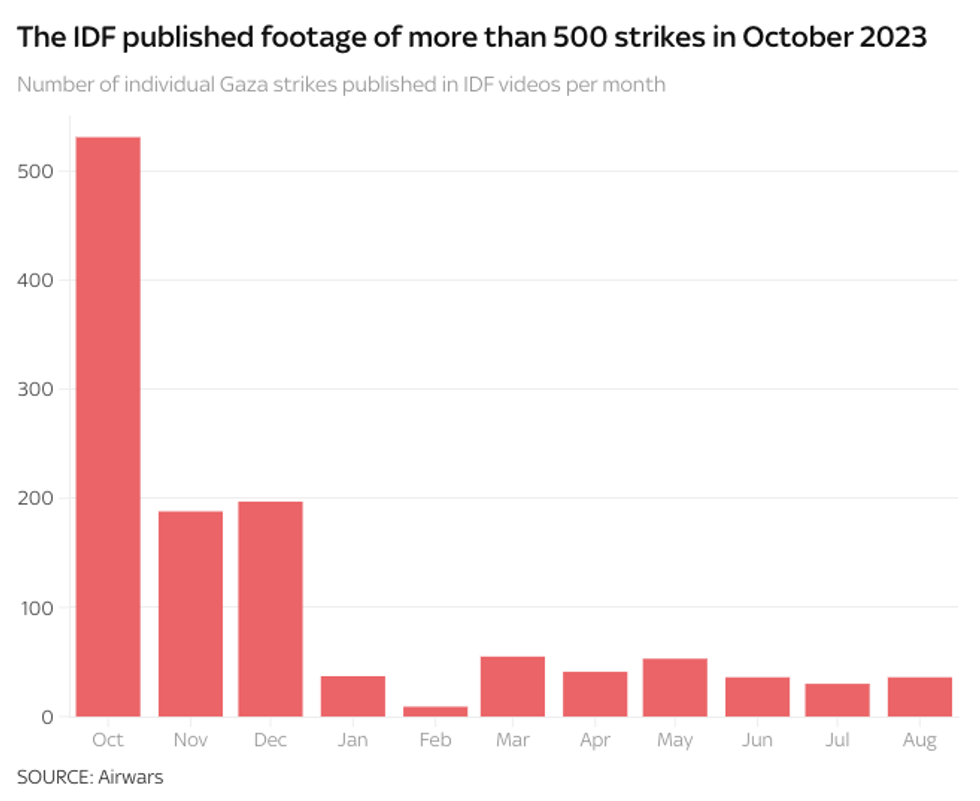The Israeli military has over the past year released triumphant videos of airstrikes in Gaza that are linked to hundreds of civilian deaths, according to an investigation published Wednesday by Sky News and Airwars, a watchdog group.
The Israel Defense Forces (IDF) posted videos of 1,219 strikes between October 7, 2023 and August 31—the period studied—nearly half of which came from the first month of the war. The IDF often overlays captions citing Hamas targets. Most of the videos are grainy, with people on the ground not visible, deaths not directly evident, and locations unclear.
Airwars used geolocation data to match 17 of the strikes to specific incidents in which Palestinians were reported killed or injured. The newly released investigation includes detailed reports on each of the 17 strikes, which together killed 448 civilians.
"This is incredible work by Airwars clearly showing how Israeli targeting practices are way below acceptable legal standards," Alonso Gurmendi, a human rights fellow and war expert at the London School of Economics and Political Science, wrote on social media.
The attacks detailed in the investigation are just those Airwars was able to document, as many of the IDF's videos provided insufficient detail for analysis—Airwars could identify the location in only 72 of the 1,219 strikes, of which 17 matched with documented incidents.
Even the 1,219 published strikes are just a "fraction" of the overall number of Israeli strikes on Gaza in the last year, Airwars said in a video summarizing its findings.
"They are those that the military chose to release. The ones they wanted the world to see. But who was actually killed?" the narrator said.
Airwars' findings provide tragic answers to the question. Among the 17 attacks that the watchdog group examined in detail was a strike on a seven-story residential building called al-Taj in a relatively well-to-do neighborhood in Gaza City on October 25, 2023. The strike, which the IDF posted on X two days later, killed 101 civilians including 44 women and 37 children.
Marwa Jarada, a 25-year-old Palestinian woman who lives in the United States, lost at least 16 family members in the strike, including her parents and her sisters.
"My family was everything to me," Jarada toldSky News. "They are my life. And I've lost everyone I love."
Jarada and another relative said that the IDF didn't issue a warning that the strike was coming.
The relative, Hisham Ahmad Saleh, told the investigative team that "if there had been any [warning] like you mentioned, they would have taken precautions, they would have dressed and gone out, but no, they did not receive any information at all."
The IDF didn't respond to specific Sky News questions on whether a warning was issued, but did reject Airwars' claims more generally.
Legal experts said a lack of warning to civilians prior to the al-Taj attack could amount to a violation of international law, especially given the IDF's stated reason for the attack: to destroy a Hamas military tunnel.
"A tunnel is not going anywhere," Dearbhla Minogue, a lawyer with the Global Legal Action Network (GLAN), told the investigative team. "There's absolutely no reason you would not evacuate that building before you launch that attack."
"So I think in publishing that video, Israel has actually not left themselves with anywhere to go in relation to claiming that was a lawful attack," Minogue said.
Israel has multiple audiences in mind when publishing strike videos, experts say.
"The first narrative they want to push out, towards the domestic audience, is 'We're winning,'" Andreas Krieg, a defense and Middle East expert based at King's College London, told the investigative team.
"The number two message is one of deterrence, which is aimed at Hamas, Iran, [and] Hezbollah... to say, if you attack us, this is what will happen to you," he said.
A third audience cited by Krieg and other experts was the international community, which Israel would like to convince that its attacks are targeted. Yet "all of the footage being pushed out by the IDF suggests the opposite," Krieg says.
The number of strike videos released by the IDF has dramatically declined in the last year, which Airwars suggested could be the result of Israeli concerns that the videos would be used against them in court.
A drop-off in the number of videos occurred in January, the same month that the International Court of Justice, the highest United Nations court, held public hearings in a genocide case against Israel brought by South Africa. On January 26, the court ruled that Israel must prevent acts of genocide in Gaza.

Minogue, the GLAN lawyer, said the videos could be used to hold Israeli decision makers accountable.
"It's definitely and absolutely the case that these videos could be used as criminal evidence against Israeli defendants, because they show so much," she said.
More than 41,000 Gazans have been killed by Israeli forces over roughly the last year. Hamas and allied Palestinian militant groups killed about 1,200 Israelis in an attack on southern Israel on October 7, 2023 and also took about 250 hostages.


